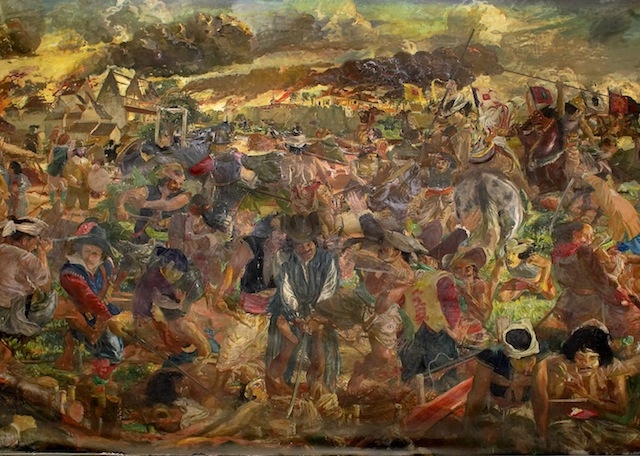BOZAR, Brussels, 18 October – 21 January
Though Indonesia’s independence from its former colonisers, the Netherlands, can be accurately dated to 1945, when president-elect Sukarno and his vice-president Mohammad Hatta proclaimed the country’s self-government, it would be a historical falsification to pretend that this moment happened out of the blue. With Power and other things, whose somehow strange but fascinating title is excerpted from the Indonesian declaration of independence, curators Riksa Afiaty and Charles Esche want to sketch various anticipatory episodes of resistance ingrained within the country’s rich yet violent history.
The exhibition begins with two different nineteenth century paintings of Diepo Negoro, leader of the uprising during the Java War (1825–30), depicting the same moment he was arrested by the Dutch. The work by the Java-born Raden Saleh portrays Negoro with chin proudly upraised; that by Dutch artist Nicolaas Pieneman hymns the colonial system, with soldiers in impeccable uniforms and the Dutch flag waving high. The titles, too, are revealing: while Saleh’s work is simply called The Arrest of Pangeran Diponegoro (1857), Pieneman’s bears the more triumphant The Submission of Prince Dipo Negoro to General De Kock (c. 1835). The juxtaposition is a perfect opening for a show that wants to rewrite history, recognising all too well that each side has its story and that historical narrative is often used and adapted to one’s advantage.
Though to open with such early works would suggest otherwise, the exhibition is not set up chronologically. Instead, it moves back and forth in time, illustrating how certain phenomena keep returning, in various shapes, throughout history. Hence, Lidwien van de Ven’s research project in the form of video, documents, texts and enlarged pictures, Fragments (of a desire for revolution) (2017), emphasises not only an example of resistance preceding Indonesia’s independence – uprisings by the Communist Party in 1926–7 – but also the often-forgotten role of women in this story, focusing on one of them, activist Raden Sukaesih. The next chapter veers back in time by showing a copy of (and preparatory sketches for) the triptych The Battle between Sultan Agung and Jan Pieterszoon Coen (1973), a work commissioned from the artist Sudjojono by the then-governor of Jakarta, Ali Sadikin. By depicting the first struggle against colonial rule, the new Suharto regime (to which Sadikin belonged) wanted to inscribe itself within that tradition of resistance.
The dioramas inside the National Monument (colloquially known as Monas) in Jakarta were another way for the nation to portray itself by visualising its coming-into-being through various episodes. For I was born in Indonesia (2017), Tom Nicholson takes this format as a starting point for another story: that of refugees who end up stranded in Indonesia because of Australia’s tough immigration policy. His contemporary version consists of little sculptures of hugging veiled women and a person wading through water, episodes also told by the refugees themselves in the videos next to Nicholson’s diorama.
While the dark pages from colonial history are not eschewed, neither are these from the post-independence period, illustrating the often-used metaphor of the victim becoming a villain. As a response to a communist plot in 1965–6, the new president Suharto took advantage of the events to purge communists and ethnic Chinese, leading to a death toll estimated as between half-a-million and three million. Here both FX Harsono and Agung Kurniawan refer to that horror, the former by making rubbings from gravestones of people from the Chinese minority, which he presents here on pieces of textile attached to the wall and through a video installation (Pilgramage to history, 2013); the latter by interviewing female prisoners about their fate and projecting their testimonies on their clothes. Kurniawan’s work Gentayangan (2017) is preceded by Wendelien van Oldenborgh’s No False Echoes (2008); this video, though, could have served as the show’s grand finale. For it, van Oldenborgh took Soewardi Soerjaningrat’s 1913 pamphlet If I were a Dutchman, a bitter attack on the colonial regime, and asked the Dutch-Moroccan rapper Salah Edin to perform the text. The result, a decade-old artwork concerning a century-old sentiment, feels shockingly up-to-date: social exclusion and segregation live on, merely assuming new shapes.
From the December 2017 issue of ArtReview
